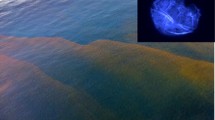Abstract
A Cd-binding complex was isolated from Chlorella fusca and has been shown to be composed of phytochelating peptides, (γ-Glu-Cys) n -Gly, n=2–5. Members of six of the ten classes of Phycophyta revealed phytochelatin synthesis after exposure to cadmium ions. Phytochelatin was also induced by ions of lead, zinc, silver, copper and mercury. These experiments uneqiovocally demonstrated that algae sequester heavy metals by an identical mechanism as higher plants, namely via complexation to phytochelatins.
Similar content being viewed by others
References
Becker EW (1986) Nutritional properties of microalgae: potentials and constraints. In: Richmond A (ed) CRC Handbook of microalgal mass culture. CRC Press Inc, Boca Raton, Florida, pp 339–376
Chang J-Y (1981) N-Terminal sequence analysis of polypeptide at the picomole level. Biochem J 199:557–560
Chu SP (1942) The influence of the mineral composition of the medium on the growth of planctonic algae. I. Methods and culture media. J Ecol 30:284–352
Connell GE, Adamson ED (1970) γ-Glutamyltranspeptidase. In: Perlmann GE, Lorand L (eds) Methods in enzymology, vol 19. Academic Press, New York, pp 782–789
Ellman GL (1959) Tissue sulfhydryl groups. Arch Biochem Biophys 82:70–77
Frankel M, Gerstner D, Jacobson H, Zilkha A (1960) Synthesis of poly-S-alkyl-L-cysteines. J Chem Soc (Lond) 1960:1390–1393
Gingrich DJ, Weber DN, Shaw CF, Garvey JS, Petering DH (1986) Characterization of a highly negative and labile binding protein induced in Euglena gracilis by cadmium. Environ Health Perspect 65:77–85
Grill E, Winnacker E-L, Zenk MH (1985a) Phytochelatins: the principal heavy metal-complexing peptides of higher plants. Science 230:574–576
Grill E, Zenk MH, Winnacker E-L (1985b) Induction of heavy metal-sequestering phytochelatin by cadmium in cell cultures of Rauvilfia serpentina. Naturwiss 72:432–434
Grill E, Winnacker E-L, Zenk MH (1986a) Synthesis of seven different homologous phytochelatins in metal-exposed Schizosaccharomyces pombe cells. FEBS Lett 197:115–120
Grill E, Gekeler W, Winnacker E-L, Zenk MH (1986b) Homophytochelatins are heavy metal-binding peptides of homoglutathione containing Fabales. FEBS Lett 20:47–50
Grill E, Winnacker E-L, Zenk MH (1987) Phytochelatins, a class of heavy metal-binding peptides from plants, are functionally analogous to metallothioneins. Proc Natl Acad Sci USA 84:439–443
Hart BA, Bertram PE (1980) A cadmium-binding protein in a cadmium tolerant strain of Chlorella pyrenoidosa. Envir Exp Bot 20:175–180
Hayashi Y, Nakagawa CW, Murasugi A (1986) Unique properties of Cd-binding Peptides induced in fission yeast, Schizosaccharomyces pombe. Environ Health Persp 65:13–19
Hirs CWM (1956) The oxidation of ribonuclease with performic acid. J Biol Chem 219:611–621
Kägi JHM, Kojima Y (1987) Metallothionein, II. Birkhäuser, Basel
Kägi JHM, Nordberg M (1979) Metallothionein, I. Birkhäuser, Basel
Kessler E (1986) Limits of growth of five Chlorella species in the presence of toxic heavy metals. Arch Hydrobiol [Suppl] 73: 123–128
Krauss E, Schmidt A (1987) Sulphur sources for growth of Chlorella fusca, and their influence on key enzymes of sulphur metabolism. J Gen Microbiol 133:1209–1219
Lue-Kim H, Rauser WE (1986) Partial characterization of a cadmium-binding protein from roots of tomato. Plant Phys 81:896–900
Müller H (1972) Wachstum und Phosphatbedarf von Nitzschia actinastroides (Lemm) var. Goor in statischer und homokontinuierlicher Kultur unter Phosphatlimitierung. Arch Hydrobiol Suppl 38:399–484
Murasugi A, Wada C, Hayashi Y (1983) Occurrence of acid-labile sulfide in cadmium-binding peptide I from fission yeast. J Biochem 93:661–664
Nagano T, Watanabe Y, Hida K, Suketa Y, Okada S (1982) Production of cadmium-binding protein in Chlorella ellipsoidea. Eisei Kagaku 28:83–88
Nagano T, Miwa M, Suketa S, Okada S (1984) Isolation, physicochemical properties, and amino acid composition of a cadmium-binding protein from cadmium-treated Chlorella ellipsoidea. J Inorg Biochem 21:61–71
Newton GL, Dorian R, Fahey RC (1981) Analysis of biological thiols: derivatization with monobromobimane and separation by reverse-phase high-performance liquid chromatography. Anal Biochem 114:383–387
Sanger F (1949) The terminal peptides of insulin. Biochem J 45:563–574
Schlösser UG (1982) Sammlung von Algenkulturen (SAG). Ber D Bot Ges 95:181–276
Stokes PM, Maler T, Riordan JR (1977) A low molecular weight copper-binding protein in a copper tolerant strain of Scenedesmus acutiformis. In: Hemphil DD (ed) Trace substances in environmental health — XI. Univ. of Missouri Press, Columbia MO, pp 146–154
Weber DN, Shaw CF, Petering DH (1987) Euglena gracilis cadmium binding Protein-II contains sulfide ion. J Biol Chem 262:6962–6964
Author information
Authors and Affiliations
Rights and permissions
About this article
Cite this article
Gekeler, W., Grill, E., Winnacker, EL. et al. Algae sequester heavy metals via synthesis of phytochelatin complexes. Arch. Microbiol. 150, 197–202 (1988). https://doi.org/10.1007/BF00425162
Received:
Accepted:
Issue Date:
DOI: https://doi.org/10.1007/BF00425162




